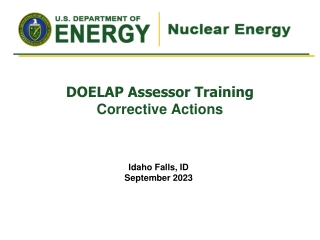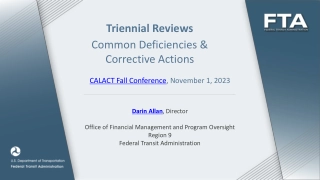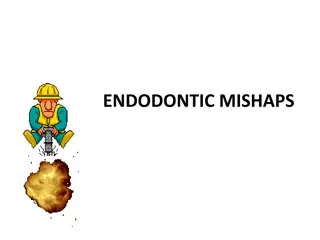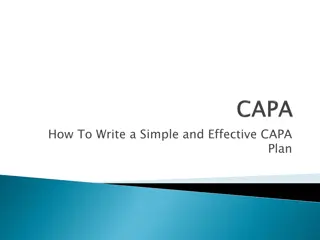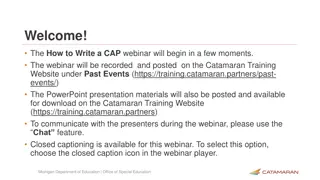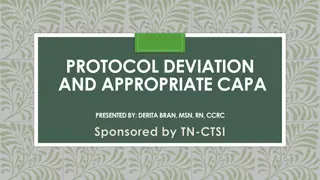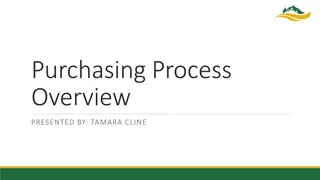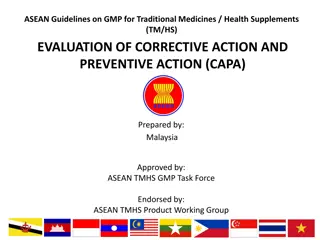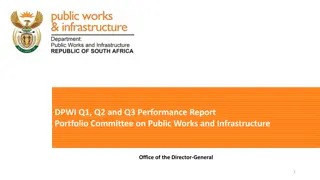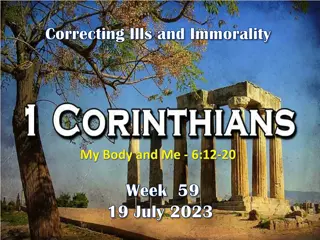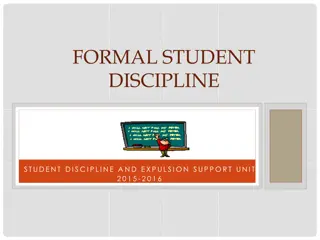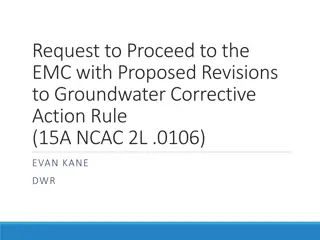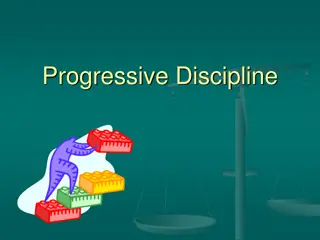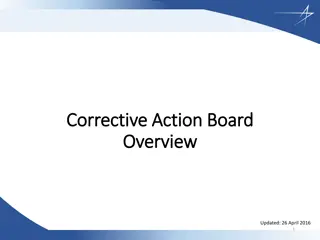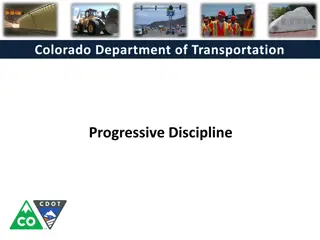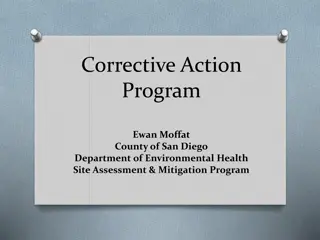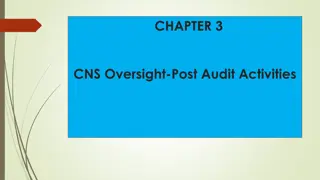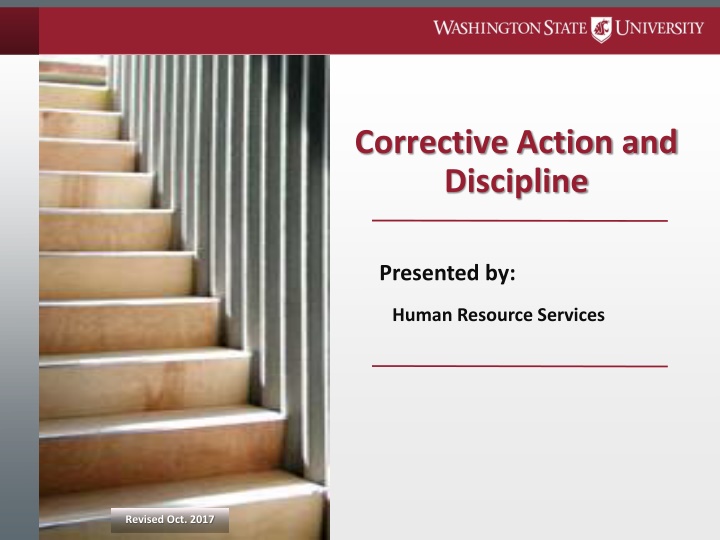
Corrective Action and Discipline in the Workplace
Explore the need for corrective action, differences from disciplinary action, benefits, progression of actions, and identifying performance deficiencies in this comprehensive guide.
Download Presentation

Please find below an Image/Link to download the presentation.
The content on the website is provided AS IS for your information and personal use only. It may not be sold, licensed, or shared on other websites without obtaining consent from the author. If you encounter any issues during the download, it is possible that the publisher has removed the file from their server.
You are allowed to download the files provided on this website for personal or commercial use, subject to the condition that they are used lawfully. All files are the property of their respective owners.
The content on the website is provided AS IS for your information and personal use only. It may not be sold, licensed, or shared on other websites without obtaining consent from the author.
E N D
Presentation Transcript
Corrective Action and Discipline Presented by: Human Resource Services Revised Oct. 2017
Objectives Overview of Policies and Procedures Corrective Action Process Disciplinary Process
Is there a need for CORRECTIVE ACTION in the workplace? Why or Why not? What is the difference between CORRECTIVE ACTION and DISCIPLINARY ACTION?
Corrective Actions Are . . . Preventative measures taken to promote compliance with established agency rules and expectations; to change unacceptable behavior.
Benefits of Corrective Action Communication Provides Opportunity to Adjust Accountability Standardizes Process
Disciplinary Actions are . . . Formal, pay affecting actions, taken when either corrective measures fail to correct problem OR seriousness of offense warrants more formal measures Imposed only by appointing authority (per BPPM 60.10. See HRS webpage to find out who the AA for your area is)
Progressive Typically, both corrective and disciplinary actions are progressive -- starting at the lowest level, and then progressing up the steps. However, this depends on the specifics of each case
Progression of Corrective Action Letter of Reprimand Letter of Concern Notice of Counseling Verbal Counseling w/summary of meeting Verbal Counseling
Progression of Disciplinary Action (Appointing Authority) Dismissal Demotion Reduction in Pay Suspension (1-15 days) Pre-Disciplinary Notice
Identifying a Performance Deficiency Review the following: Position description, goals and expectations Are they current and accurate? Last Performance Reviews or Annual Review Did the employee receive previous corrective actions? Did the employee receive previous discipline? Applicable policies and/or procedures - university and departmental: Was it communicated to staff? How was it communicated?
Addressing Performance Issues Determine who will meet with employee. Immediate supervisor You and Director/Chair You and immediate supervisor Consider setting and location State concerns and issues clearly Reminder: Do not state to the employee that this is a HRS meeting or a HRS imposed meeting. Focus on behavior, not person Indicate seriousness of problem Clarify expectations
Clear Rules & Guidelines Are more effective when they are: Needed Communicated Understood Written/Recorded Applied equally Enforced
Department Expectations Typical examples of department expectations: Hours of work Overtime rules Dress Code Requesting annual leave Call-in procedures for sick leave
Examples Your employee Jane Doe Smith is the receptionist for the department. Her work schedule is 8 am to 5 pm. For the last month she arrives to work around 8:15 am at least 1-day per week. How would you address the situation?
Examples Your employee Jane Doe Smith continues to be late to work. She is now taking longer breaks and extending her lunch period. How would you handle this situation?
The Wrong Way to Document On June 5, met with Joe Adams, verbally counseled about improper behavior. As written will you remember the behavior ?
The Right way On June 5, Joe Adams was verbally warned about his inability to meet deadlines and failure to come into work at his designated start time(s) on dates(s).
Another Wrong Way Joe Adams is unable to do his job. How would you correct this note?
The Right Way Joe Adams did not complete [Name] project by the established deadline of [date] and has been late to work by more then 15 minutes on [date, date and date].
Employee Situation This month, your employee John Jones has been absent every week on Friday and/or Monday and late for work without calling in to you six times. Last month you issued him a Notice of Counseling for similar behavior. How would you handle this situation?
During a Corrective Action Meeting Let the employee respond Listen Don t Interrupt Don t lose your temper Don t argue Consider/Reconsider course of action based on employee input
Tips Apply corrective consistently, fairly and impartially Set a good example Don t save up concerns Praise in public criticize in private Contact HRS for guidance
Things to be Aware of Notice of Investigation Timeliness Double Discipline Due Process Union Contract
Notice of Investigation Depending on the issue/situation a Notice of Investigation (NOI) may be appropriate to give. Bargaining unit covered employees must receive a written NOI within 10 working days from the date the supervisor or manager becomes aware of the situation.
More Samples of Investigations: Allegations of inappropriate use of state resources Allegation of workplace violence Office for Equal Opportunity (OEO): Allegation of harassment or discrimination
Double Discipline Cannot discipline for conduct which was previously addressed as corrective action (verbal or written).
Considering Disciplinary Action Contact HRS for guidance Issue a Pre-Disciplinary Notice Schedule a Pre-Disciplinary Meeting Appointing Authority should attend meeting HRS attends the meeting
Examples Employee John Smith over the past month has been consistently late for work and on two separate occasions was a no-call no-show. How would you handle this situation?
Pre-Disciplinary Meeting This is the Employee s meeting Employee is allowed to have a union representative or co-worker attend Meeting is voluntary, employee can respond in writing or not attend After the meeting, the Appointing Authority makes decision, taking into consideration employee s input
Considerations Does the proposed discipline fit the violation? Is the proposed discipline likely to correct behavior? Review prior performance issues Review performance evaluations Extenuating circumstances Seriousness of the offense
Disciplinary Action Letter Action is decided AFTER employee has had the opportunity to respond If disciplinary action is decided, the appointing authority notifies employee in writing of action. HRS drafts the letters.
How Would You Handle Your employee walks off the job without permission: The employee requests use of annual leave the next day to cover time missed. Should you approve use of annual leave?
More You send your employee home due to inappropriate behavior: Are you required to pay the employee?
More You gave your employee a pre- disciplinary notice. Employee calls in sick the next day, completes Family Medical Leave (FML) paperwork and is approved. What happens to the pre-disciplinary process?
Memo & Letter Templates HR Consultants are available to provide guidance with employee issues including verbal counseling, and writing corrective action memos or letters. HRS and the appointing authority draft disciplinary action letters. Web resources are also available in the Managers Section at www.hrs.wsu.edu
Probationary & Trial Service Probationary Employees Performance concerns Previously discussed behavior continues Requires 1 day written notice (WAC 357-46) Template of notification letter on HRS website Trial Service Employees Recommended that employee is notified of deficiency AND allowed a reasonable amount of time for improvement before reversion Requires 7 calendar days written notice for civil service, 15 calendar days for BU
Question What are the possible implications of an employee not performing at highest standards passing a probationary or trial service period?
Resources WAC 357-37, 38 Collective Bargaining Unit Agreements HRS Website hrs.wsu.edu Corrective/Discipline Guide For assistance and answers to questions contact HRS at 335-4521, or hrs@wsu.edu
This has been a WSU Training Videoconference If you attended this live training session and wish to have your attendance documented in your training history, please notify Human Resource Services within 24 hours of today's date: hrstraining@wsu.edu

